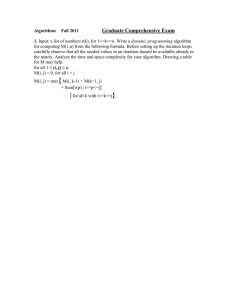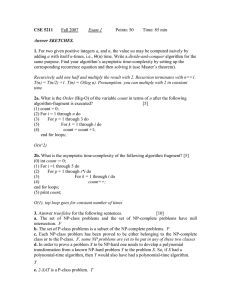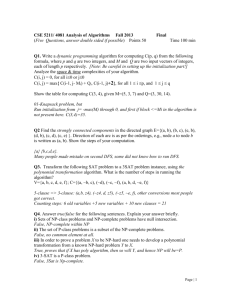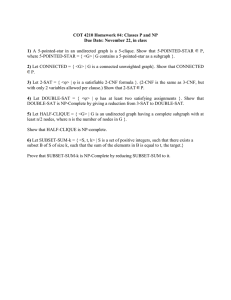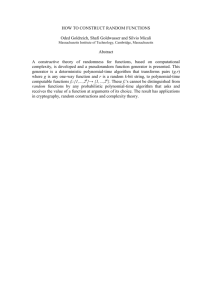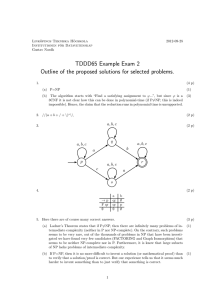Algorithms Fall 2006 Graduate Comprehensive Exam
advertisement
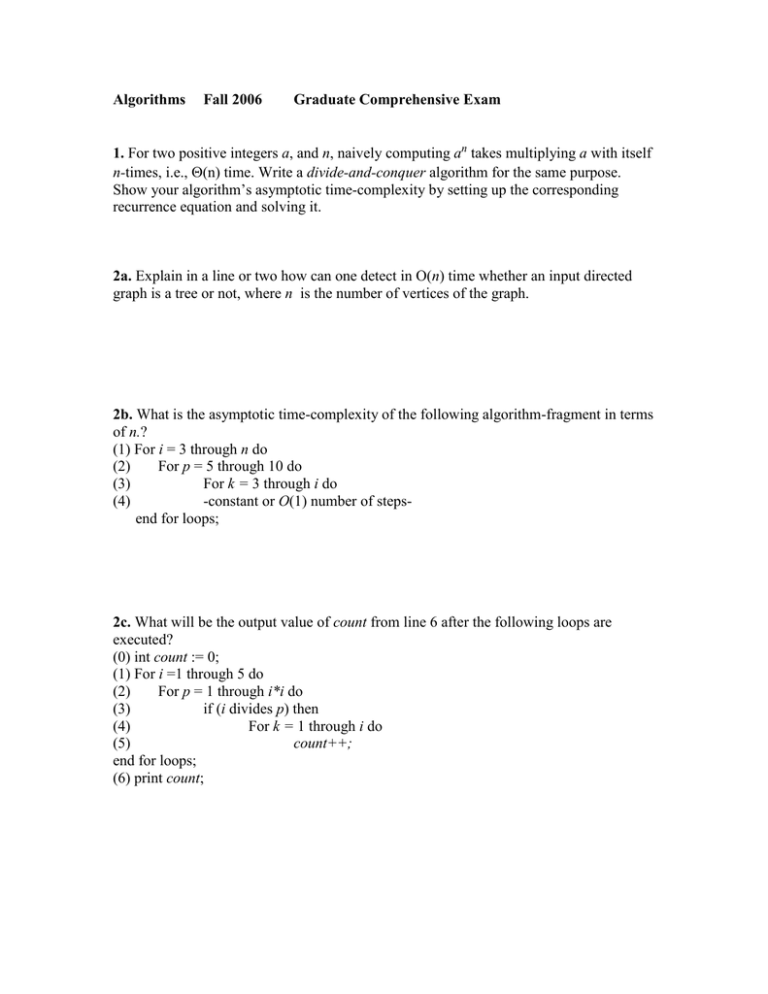
Algorithms
Fall 2006
Graduate Comprehensive Exam
1. For two positive integers a, and n, naively computing an takes multiplying a with itself
n-times, i.e., (n) time. Write a divide-and-conquer algorithm for the same purpose.
Show your algorithm’s asymptotic time-complexity by setting up the corresponding
recurrence equation and solving it.
2a. Explain in a line or two how can one detect in O(n) time whether an input directed
graph is a tree or not, where n is the number of vertices of the graph.
2b. What is the asymptotic time-complexity of the following algorithm-fragment in terms
of n.?
(1) For i = 3 through n do
(2)
For p = 5 through 10 do
(3)
For k = 3 through i do
(4)
-constant or O(1) number of stepsend for loops;
2c. What will be the output value of count from line 6 after the following loops are
executed?
(0) int count := 0;
(1) For i =1 through 5 do
(2)
For p = 1 through i*i do
(3)
if (i divides p) then
(4)
For k = 1 through i do
(5)
count++;
end for loops;
(6) print count;
3. For a weighted undirected graph G a culprit set C of arcs has the following property: if
all the elements of C are removed from G it becomes acyclic (tree), and a min-culprit set
M of arcs is such that the aggregate weight of arcs in M is minimum for all such sets C.
Write a greedy algorithm to find M given a graph G.
[Hint: First try to find appropriate G – M.]
What is the asymptotic time-complexity of your algorithm?
4. Write a dynamic programming algorithm for computing C(1,n) from the following
recurrence formula. Analyze the time-complexity of your algorithm.
Input to the algorithm: an array of integers pi, 1 i n, for problem size n.
C(i, i-1) = 0, for all 1 i n.
C(i, i) = pi, 0 i 0 n+1,
C(i, j) = min{ C(i, k-1) + m=i j pm , C(k+1, j) + m=i j pm
| for all k with i k j},
for all 1 i < j n
5. Answer true/false for the following sentences. Explain your answer only if you cannot
answer as true/false.
a. Sets of NP-class problems and NP-complete problems have non-null intersection.
b. The set of P-class problems is a subset of the NP-complete problems.
c. Each problem which is not yet proved to be NP-complete necessarily has a
polynomial-time algorithm.
d. In order to prove a problem X to be NP-hard one needs to develop a polynomial
transformation from a known NP-hard problem Y to X. So, if X has a polynomial-time
algorithm, then Y will also have a polynomial-time algorithm.
e. 2-SAT (where each clause in a Boolean Satisfiability problem (SAT) has two literals)
is a P-class problem. So, SAT is in P
NP-complete.
f. There exists a polynomial-time algorithm for finding the shortest paths between all
pairs of nodes in a directed and weighted graph.
g. QuickSort algorithm takes O(n2) time for running on an already sorted array of size n.
h. This sentence (in question 5h) is false.
i. Suppose that G is a connected and undirected graph. If removing edge e from G
disconnects the graph, then e is a tree edge in the depth-first search spanning-tree of G.
j. Suppose that e is a minimum weight edge of a weighted undirected graph G, and all the
edge weights are distinct. Then e is always contained in the minimum spanning tree of G.
